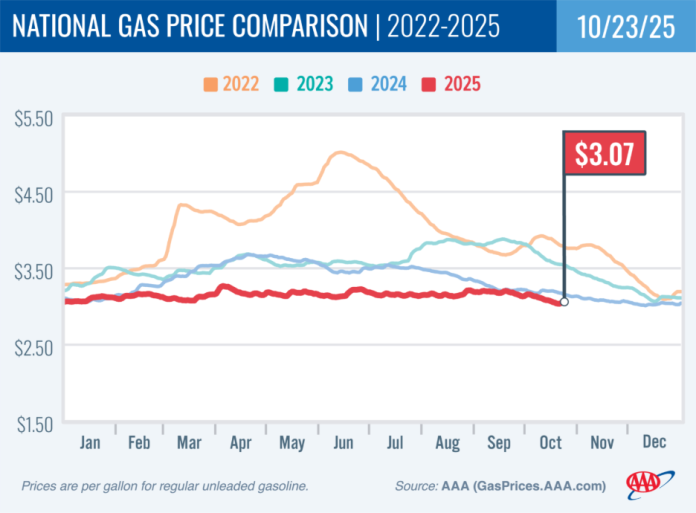As the weather shifts and the holiday season approaches, gas prices across the United States show a notable stability that could impact small businesses reliant on transportation and delivery services. The national average for a gallon of regular fuel has ticked up slightly, now sitting at $3.07—only a few cents higher than last week. Interestingly, this represents a decrease compared to prices from a year ago, indicating beneficial trends for cost-conscious consumers and businesses alike.
The recent findings from the Energy Information Administration (EIA) reveal that gasoline demand remains steady at 8.45 million barrels per day, while the overall domestic gasoline supply has dropped from 218.8 million barrels to 216.7 million. In contrast, gasoline production has ramped up, averaging 9.6 million barrels per day, which may contribute to the lower prices.
For small business owners, maintaining a grip on fuel costs is vital. Regular fluctuations in gas prices can directly impact operational expenses, especially for those involved in logistics, delivery services, or any business requiring transportation. A stable or decreased gas price allows businesses to better forecast their monthly operating costs and potentially increase profit margins. Moreover, as gasoline demand typically declines in the fall when fewer people are traveling, this could suggest continued stability for the foreseeable future.
Another aspect of the current fuel landscape is the oil market dynamics. Recently, West Texas Intermediate (WTI) crude oil saw a $1.26 rise, ending the session at $58.50 a barrel. Although crude oil inventories are about 4% below the five-year average for this time of year, industry analysts suggest that these fluctuations are not likely to translate into significant changes at the pump. Nonetheless, small business owners should stay informed about crude price trends, as these can eventually ripple through to consumer pricing.
In addition to conventional fuel concerns, electric vehicle (EV) owners may be taking stock of the average public charging costs. Currently stable at 36 cents per kilowatt hour, this pricing presents another dimension for small businesses to consider, particularly those looking to transition to electric fleets. Those who provide services in states with cheaper charging options—like Kansas (26 cents per kWh)—might find this beneficial as they assess potential shifts toward electric vehicles.
Generally, the top 10 most expensive states for gas include California, Hawaii, and Washington, where prices can soar above $4.00 per gallon. Conversely, states such as Mississippi and Texas consistently offer more affordable options, which can be advantageous for regional businesses trying to minimize fuel expenses. Understanding these state-level differences can inform operational strategies for cost management.
While these gas and energy trends present opportunities for small businesses, there are challenges to keep in mind. For instance, fluctuations in oil prices can occur suddenly, potentially destabilizing the current landscape without warning. Moreover, continued discussion around transitioning toward sustainable energy solutions may require businesses to invest in alternative fuel options or EV infrastructure, a shift that can involve significant costs and require intricate planning.
In light of these evolving conditions, small business owners are encouraged to monitor fuel prices and energy costs closely, ensuring they remain adaptable to changes that could impact their operations. Using tools such as the AAA TripTik Travel planner can assist in reliably determining current fuel and electric charging prices along various routes, aiding businesses in maintaining efficiency in travel and logistics.
For those eager to stay ahead of the curve, leveraging the present gas price stability could open new avenues for growth and operational efficiency throughout the colder months ahead. Small business owners would do well to remain vigilant and informed as they navigate this ever-changing landscape. Further details can be found in the original post at AAA Gas Prices.
Image Via Gas Price



